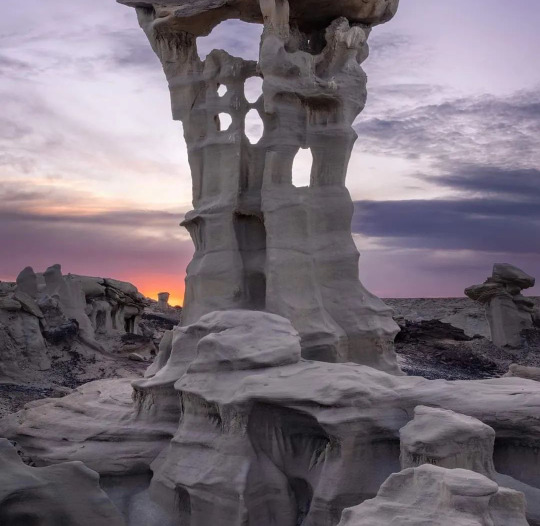#Bisti/De-Na-Zin Wilderness Area
Video
I’m Letting the Bisti Memories Start Here by Mark Stevens
#A Large Area of Shale Hills#Among the Adobe Formations#Azimuth 77#Badlands#Bisti Abstract#Bisti Badlands#Bisti/De-Na-Zin Wilderness Area#Blue Skies#Blue Skies with Clouds#Chaco-San Juan Basin#Colorado Plateau#Day 3#Desert Landscape#Desert Mountain Landscape#Desert Plant Lifes#DxO PhotoLab 7 Edited#High Desert#Hoodoo Rock Formations#Hoodoos#Intermountain West#Landscape#Landscape - Scenery#Looking East#Nature#New Mexico and Mesa Verde National Park#Nikon D850#No People#Outside#Partly Cloudy#Partly Sunny
2 notes
·
View notes
Text

moonrise 🌝
#click this for sick pano#had a very nice time exploring Climates but im so glad to be cuddling my dog again#also. cool clouds in this pic due to a hail storm(??) we got caught in. almost didnt make it#the 'roads' were so flooded and washed out lmfao#tell me how we managed to get stuck in TWO hailstorms one day after the other. with like 100 miles between. what#oh yeah this is near the bisti/de-na-zin wilderness area in nw new mexico. iphone says bloomfield#update ive since learned these are anticrepuscular rays. altho the moon did rise in that area and it was in fact huge and bright
3 notes
·
View notes
Text
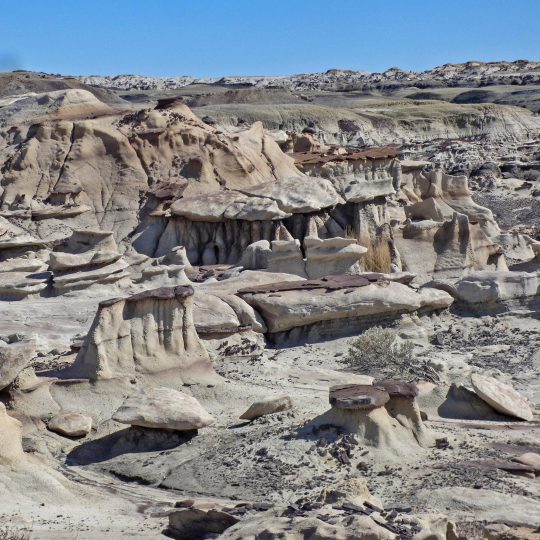
The Bisti/De-Na-Zin Wilderness encompasses 41,170 acres of rock formations that would seem more natural on Mars. It is one of several protected badlands in the Four Corners area. Ah-She-Sle-Pah Wilderness is a few miles south. Angel Peak badlands is about 20 miles northeast.
#NewMexico#OptOutside#roadtrip#travel#daytrip#nature#geology#whataview#scenic#New Mexico#badlands#new mexico landscape
53 notes
·
View notes
Text
Bisticeratops froeseorum Dalman et al., 2022 (new genus and species)

(Type skull of Bisticeratops froeseorum, from Dalman et al., 2022)
Meaning of name: Bisticeratops = Bisti/De-na-zin Wilderness Area horned face [in Greek]; froeseorum = for Edgar Froese [the late founder of the band Tangerine Dream] and Jerome Froese [former member of Tangerine Dream and founder of the band Loom]
Age: Late Cretaceous (Campanian), about 74 million years ago
Where found: Kirtland Formation, New Mexico, U.S.A.
How much is known: Nearly complete skull of one individual.
Notes: Bisticeratops was a chasmosaurine ceratopsian, making it a fairly close relative of Triceratops. The holotype skull of Bisticeratops was originally considered a specimen of Pentaceratops, another chasmosaurine from the Campanian of New Mexico. However, a new study identifies several distinguishing features that suggest it is a separate species. In addition, Bisticeratops is approximately 2 million years younger than Pentaceratops proper. Along with several other recently named ceratopsians, such as Sierraceratops, Navajoceratops, and Terminocavus, Bisticeratops shows that chasmosaurine diversity was very high in the Campanian of southwestern North America.
The Bisticeratops type specimen is also noteworthy in that it preserves multiple bite marks that were likely made by tyrannosaurids. One of these bite marks shows signs of healing, indicating that this individual had survived at least one attack from a predator.
Reference: Dalman, S.G., S.E. Jasinski, and S.G. Lucas. 2022. A new chasmosaurine ceratopsid from the Upper Cretaceous (Campanian) Farmington Member of the Kirtland Formation, New Mexico. New Mexico Museum of Natural History and Science Bulletin 90: 127–153.
88 notes
·
View notes
Text

The Bisti Badlands, New Mexico...
These surreal rock formations are some of New Mexico's greatest treasures. The Bisti/De-Na-Zin Wilderness is a 45,000-acre (18,000 ha) wilderness area located in San Juan County in the U.S. state of New Mexico. Sediments that created them were deposited 75 million years ago, as the dinosaurs still roamed the Earth. Then, millions of years of erosion formed these residual formations. Once covered in swamps and deltas of the Western Interior Seaway, the area was filled with sediments and organic materials in prehistoric times. This particular image shows a formation called the "cracked eggs", which are the result of differential erosion between hard and soft sediments.
Credit: John Fowler via Flickr https://buff.ly/3PdivAn
2 notes
·
View notes
Photo

Rock formations called “hoodoos” fill the Bisti De-Na-Zin Wilderness in northern New Mexico. The desert area is rich with fossils from dinosaurs and animals that lived here in ancient times.
PHOTOGRAPH BY EFRAIN PADRO, ALAMY STOCK
#efrain padro#photographer#alamy stock#national geographic#rock formations#hoodoos#desert#bisti de-na-zin wilderness#new mexico#nature#landscape
17 notes
·
View notes
Text
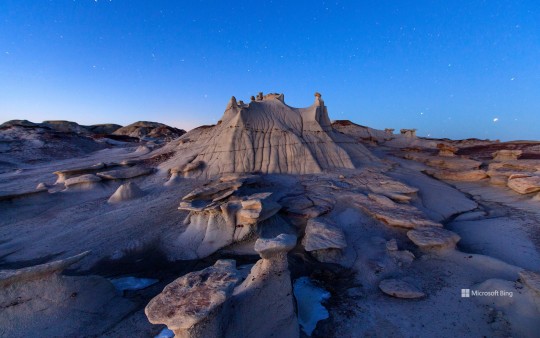
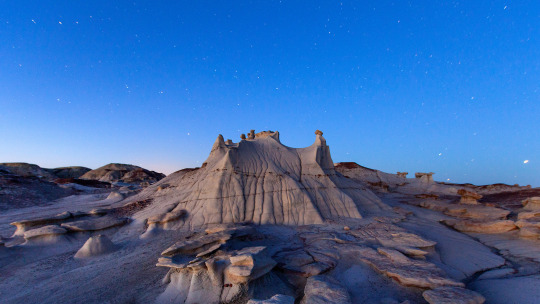
Bisti/De-Na-Zin Wilderness Area, New Mexico
© Ian Shive/Tandem Stills + Motion
Featured on Bing- March 9, 2024
Bisti/De-Na-Zin Wilderness, New Mexico
Transformed by time | EN-CA, EN-CN, EN-GB, EN-US, ROW
0 notes
Photo
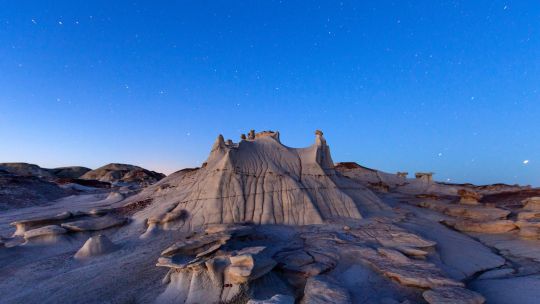
Bisti/De-Na-Zin Wilderness Area, New Mexico (© Ian Shive/Tandem Stills + Motion)
1 note
·
View note
Video
Heading off to Explore the Bisti Badlands by Mark Stevens
Via Flickr:
A setting looking to the northeast while taking in views to the badlands area where I’d be hiking and exploring in the Bisti/De-Na-Zin Wilderness Area.
#A Large Area of Shale Hills#Among the Adobe Formations#Azimuth 52#Badlands#Bisti Abstract#Bisti Badlands#Bisti/De-Na-Zin Wilderness Area#Blue Skies#Blue Skies with Clouds#Chaco-San Juan Basin#Colorado Plateau#Day 3#Desert Landscape#Desert Mountain Landscape#Desert Plant Life#DxO PhotoLab 7 Edited#High Desert#Intermountain West#Landscape#Landscape - Scenery#Looking NE#Nature#New Mexico and Mesa Verde National Park#Nikon D850#No People#Outside#Partly Cloudy#Partly Sunny#Project365#Rock Formations
2 notes
·
View notes
Text
The Bisti Badlands: A Natural Wonderland in New Mexico
The Bisti Badlands, located in northwestern New Mexico, is a unique and breathtaking destination that offers a glimpse of an alien world right here on Earth. The area is formally known as the Bisti/De-Na-Zin Wilderness and takes its name from the striking stone formations that dot the landscape, “bisti” being a Navajo term meaning “among the adobe formations.” The area is also known for…
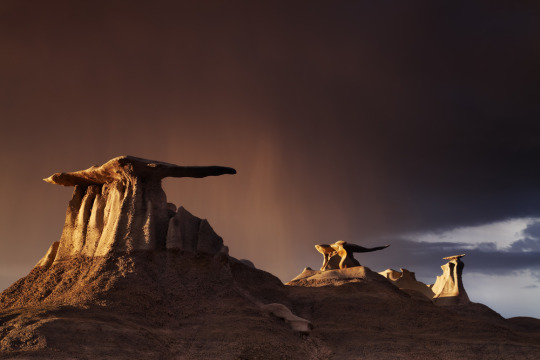
View On WordPress
0 notes
Text

Rock formations called “Hoodoos” fill the Bisti De-Na-Zin Wilderness in northern New Mexico. The desert area is rich with fossils from dinosaurs and animals that lived here in ancient times. Photograph By Efrain Padro, Alamy Stock
These Dazzling Rock Formations Stand Where Dinosaurs Once Roamed
In the high desert of New Mexico, these sprawling badlands draw hikers and photographers with otherworldly “hoodoos” and a wealth of fossils.
— By Jennifer Barger | March 31, 2022
At first glance, the windblown sandstone landscape of the Bisti/De-Na-Zin Wilderness looks like the most desolate place on Earth, an inhospitable expanse of sky, sand, and oddly shaped rock formations called hoodoos.
But millions of years ago, these badlands, in what’s now northern New Mexico, were a coastal swamp in an inland sea, alive with large trees, reptiles, primitive mammals, and meat-chomping dinosaurs.
The Navajo (Diné)—whose lands intersect and border these 41,170 protected acres—gave the area its dual names: Bisti, meaning a “large area of shale hills,” and De-Na-Zin, from the word for “standing cranes.” The high desert plains surrounding the Bisti/De-Na-Zin are about 6,500 feet above sea level, though the badlands themselves sit 200 to 400 feet below that due to erosion.

Hikers will find many winged sandstone rock formations in the Bisti/De-Na-Zin Wilderness in northern New Mexico. Photograph By Colin D. Young, Alamy Stock
To the Navajo and other Indigenous people, these lands served as a seasonal migration path, sacred grounds, and even a playground of sorts. “My cousins and I would come out here and camp and explore,” says Kialo Winters, founder of Navajo Tours USA, which leads guided trips through the wilderness. “It was a great place for hide-and-go-seek.”
It took millennia for lush wetlands to turn into these otherworldly high desert badlands, where eroded sandstone features can resemble mushrooms, towering chess pieces, or even fried eggs. Here’s how they were formed, what to look for, and how to explore this delicate region without damaging it.
A Fertile, ‘Beast’-Filled Past
Millions of years of erosion formed Bisti/De-Na-Zin Wilderness (Bisti is pronounced bis-tie) in this corner of the San Juan Basin. Once covered in swamps and deltas of the Western Interior Seaway, the area was filled with sediments and organic materials in prehistoric times. At some point, a volcanic eruption blanketed everything in ash. As the sea began to recede about 50 million years ago, dinosaurs, reptiles, and other animals thrived in the wetlands along the resulting riverbeds.

Eventually, the water disappeared entirely, leaving behind embedded layers of sandstone, mudstone, shale, and coal, which were all uplifted with the Colorado Plateau starting around 6,000 years ago. Shortly after that, the last ice age receded, and the waters of its melting glaciers carved away the rock. This formed its distinctive hoodoos and exposed Bisti’s wealth of fossils and petrified wood.
“We know from fossil plants and woods that this was once a jungle with lots of dinosaurs,” professor Spencer Lucas, curator of paleontology at the New Mexico Museum of Natural History and Science in Albuquerque. “When animals died here, they would have quickly been buried in sand and mud that preserved them.”
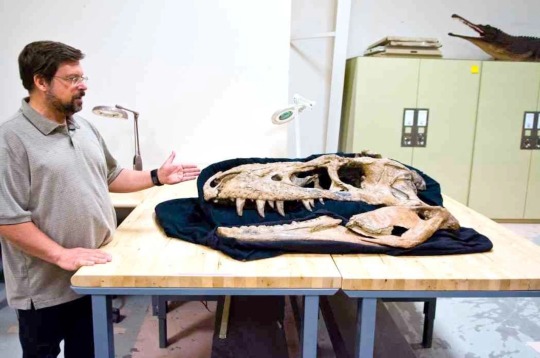
The “Bisti Beast,” a 70-million-year-old fossil skull of a species of tyrannosaur, was discovered in the Bisti/De-Na-Zin Wilderness. It is now on display at the New Mexico Museum of Natural History and Science in Albuquerque. Photograph By Marla Brose, Albuquerque Journal/Zuma Wire/Alamy Stock Photo
Scientists have discovered and excavated numerous fossils here in the protected wilderness, which is overseen by the Bureau of Land Management, an agency of the U.S. Department of the Interior responsible for safeguarding pristine natural areas set aside by the government.
The animals that once roamed these lands include duckbill dinosaurs, ancient turtles, and the “Bisti Beast.” The last, found by a volunteer in 1997, is a 29-foot-long (9-meter-long) “destroyer” dinosaur, a primitive relative of the T. rex. Now on display at the New Mexico Museum of Natural History and Science in Albuquerque, Bistahieversor sealeyi was eventually ruled an entirely new species.
Exploring the Badlands
While scientists might come to Bisti to dig for dinos, travelers are lured by the area’s rock formations, those undulating, seemingly abstract forms that create a landscape that resembles both the surface of the moon and a Looney Tunes Wild West backdrop. They’re catnip for nature photographers toting tripods or smartphones.
Shaped by wind and erosion, these spires and hoodoos range from a few feet tall to two stories high. (The term “hoodoo” may come from the Caribbean African “voodoo,” a nod to the formations’ bewitching shapes.)

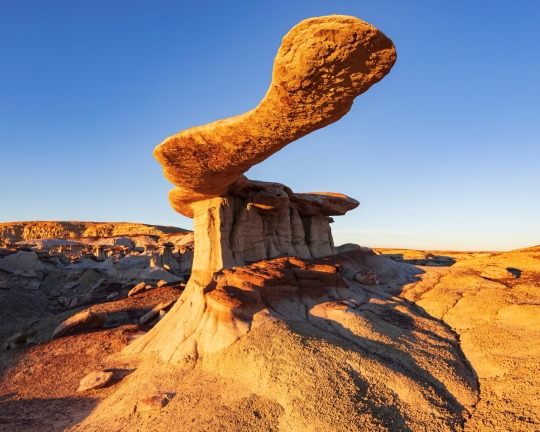
Top: Nicknamed the “cracked eggs,” these stone formations in the Bisti/De-Na-Zin Wilderness are popular with photographers. Photograph By Design Pics Inc., Alamy Stock Bottom: A winged hoodoo in the Bisti/De-Na-Zin badlands was formed by millions of years of erosion. Photograph By Jeremy Woodhouse, Getty Images
Some hoodoos are winglike; others resemble hatching eggs. “The erosional features are quite amazing, like natural art forms,” says Lucas. They can be found around “washes”—remnants of those ancient riverbeds—beginning about a mile hike in from either of the two access points to the wilderness area. Both entrances are located less than an hour drive south of Farmington, New Mexico, or an hour-and-a-half drive south of Durango, Colorado.
Due to the delicate nature of the ground and potential damage to the hoodoos, the Bisti/De-Na-Zin Wilderness can only be explored on foot or horseback.
“Be mindful to step only on firm ground,” says Winters. “The softer ‘feathered’ ground near the bases of hoodoos represents ongoing natural erosion, and you don’t want to disturb their balance.” Besides keeping your distance from the ground near hoodoos, it’s imperative not to touch them or other ancient fossils like petrified wood or shells.
While dinosaurs haven’t roamed here for about 65 million years, these badlands are surprisingly rich in wildlife, especially birds. You can spot golden eagles, towhees, and ravens in the stark desert skies or jackrabbits and cottontails amid the sand and scrub grass. At night, campers might see coyotes or, more rarely, a giant desert centipede (Scolopendra heros) which can grow up to eight inches long.
The vastness of this wilderness and the no-wheeled-vehicles rule means hikers, horseback riders, and primitive campers often have this BLM land nearly to themselves. There are no marked hiking paths from either of the entrance points to the wilderness, meaning visitors experience nature in a more freeform, less-managed way.
Unfortunately, that also means it’s easy to get lost. Some navigational skills or a guide can help in areas where phone signals are scarce. When exploring here, BLM recommends using a smartphone app or GPS device with a topographic map loaded ahead of your visit.
It’s a good idea to pack a backup of either paper maps and a compass or a second smartphone with maps loaded. BLM New Mexico has created hunting/recreation maps that can be downloaded and used with the free CarryMap App. Topographic maps can also be downloaded.
The high altitude of these desert plains means summer days can be hot and winter nights cold (and sometimes, snowy). This makes spring and fall ideal times to visit, and sunblock, sun hats, and lots of water necessary no matter the season.
0 notes
Text
Psychedelic patterns on rocks in the Bisti/De-Na-Zin Wilderness area in San Juan County, New Mexico, United States.
📷 Rick Goldwaser
Forbidden cinnamon buns

1 note
·
View note
Photo
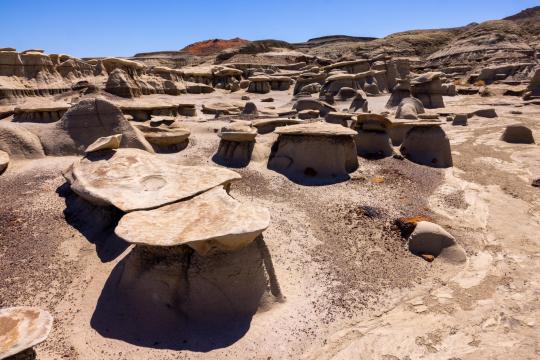
Bisti/De-Na-Zin Wilderness Area, New Mexico [OC] [2000 x 1334] via /r/EarthPorn https://ift.tt/txOHgvJ
0 notes
Photo
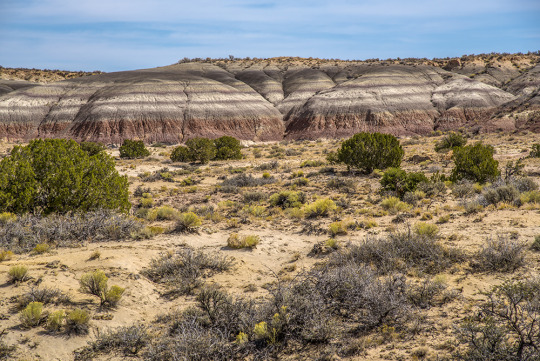
Bisti/de-na-zin Wilderness Area in Bloomfield, New Mexico
It appeared similar to the South Dakota Badlands
0 notes

